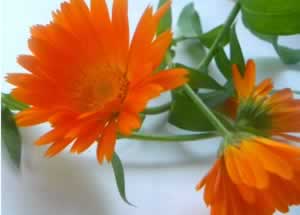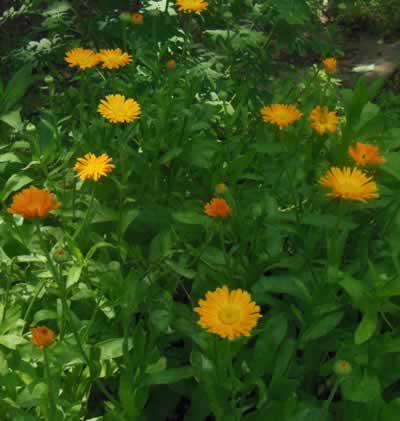Calendula Calendula officinalis

calendula flowers
- Common Names
- Calendula , Pot marigold
- Botanical Name
- Calendula officinalis
- Family
- ASTERACEAE
Medicinal Uses & Benefits of Calendula
![]() How to Use|
Side Effects |
Plant & Garden|
Folklore
How to Use|
Side Effects |
Plant & Garden|
Folklore
- Medicinal Uses: * Acne
* Beauty
* Culinary/Kitchen
* Cuts & Wounds
* Dental/Oral Care
* Eyes/Vision
* Herbal Teas
* Insect/flea Bites
* Skin Care
- Properties: * Analgesic * Anti-inflammatory * Antibacterial * Antifungal * Antiscrofulous * Astringent * Cholagogue * Depurative * Diaphoretic * Emmenagogue * Febrifuge * Midsummer * Vulnerary
- Parts Used: flowers and oil
- Constituents: carotenoids, resin, essential oil, flavonoids, sterol, bitter principle, saponins, mucilage
How to Use: Calendula
Calendula is a stunningly beautiful flower, the deep orange and yellow petals form a colorful contrast with the greenery in the herb garden. Is it little wonder that Calendula, called "Marygold", Marigold or "sunbride" in the herbals of the middle ages, was ascribed such magical powers and healing virtues? Calendula flower oil heals the skin so well, The German Commission E has verified the effectiveness of calendula in healing wounds and reducing inflammation. Tyler, pp220
Calendula is a particularly good treatment for cuts, scrapes, bruises, insect bites and minor wounds. Calendula is antifungal and so can help to cure thrush (Candida albicans). Mabey, pp46 The antibacterial and anti-inflammatory properties of calendula make it a good face wash for dry, irritated skin and acne. Fresh calendula petals can also be infused in boiling water and used to treat minor infections, conjunctivitis, and mouth sores. Calendula tinctures are also a concentrated and convenient way to treat sore or infected gums. White, pp281
Preparation Methods & Dosage :Calendula is most often applied to the skin in creams, lotions and oils, but can be taken as an herbal tea, used as a tincture, and applied as a poultice. Make a simple homemade facial by boiling a handful of fresh petals in milk. Use the flower petals to add color to soups and rice dishes. Use just the petals, do not eat calyx or flower centers. For a sore throat or indigestion, drink calendula tea or use it to gargle, for scrapes and bruises apply the tea directly to your skin. Take the sting out of insect bites and rashes by applying the bruised, fresh flowers directly to the irritated skin. Dawson, pp199-200 Use a few drops of calendula tincture to treat sore gums and mouth ulcers. Calendula combines well with comfrey and St. John's wort for healing skin.
Calendula Remedies
Calendula Side Effects: None noted
Plant Description

Calendula in the garden
- Flowers:The flowers are the part used in herbal medicine. Calendula bears many-petaled orange or yellow flowering heads two to three inches (four to seven centimeters) in diameter.
- Plant type:annual or biennial
- Leaves:The oblong green leaves help to distinguish calendula from tagetes marigolds, an unrelated species
- Preferred Habitat:
- Flowering Season:Begins in June. Its name refers to its tendency to bear flowers by the calendar, once a month in warm climates, usually during the new moon. "Marigold" refers to the Virgin Mary, and marigolds are traditionally used in Catholic celebrations concerning the Virgin Mary.
- Distribution:Native to the Mediterranean, grown widely as a garden flower, cultivated for use in herbal medicine.
Regional Traditions :European *
How to Grow Calendula
Calendula is easy to grow and is an attractive addition to your flower, vegetable, and/or herb garden. Sow seeds directly when the soil temp reaches about 60 degrees in the spring. You will be rewarded with masses of bright green foliage and sunny, yellow blooms. Harvest the flowers when they are newly opened. Pluck the petals from the dried flower heads and store in dark-colored glass jars to preserve the medicinal properties.
History and Traditions & Folklore
Calendula was attributed many fantastic virtues by the older herbalists. The salve, preferably cooked in goats lard, was used for burns, bruises and sunburns like it is today. (Minus the goats)During the American Civil War, calendula petals were used to staunch wounds.
Marigolds are called after the Virgin Mary. In Macer's Herbal it is stated that only to look on Marigolds will draw evil humours out and strengthen the eyesight.
Calendula, called "Marygold" or "sunbride" in the Middle Ages, was sacred to the Norse goddess Freya and was used for love magic. Claudia Muller-Ebeling, Wolf-Deieter Storl Witchcraft Medicine(1998)











